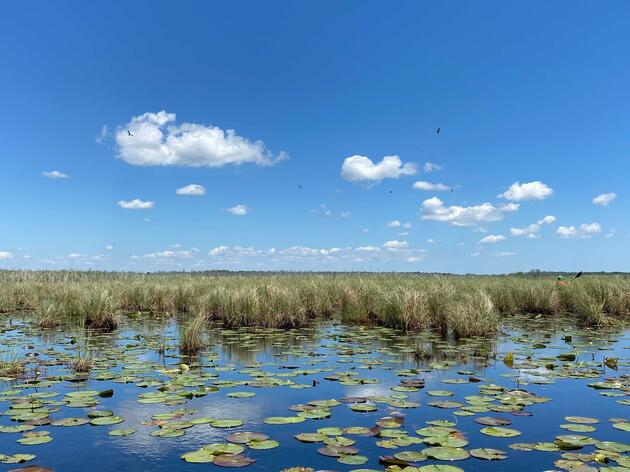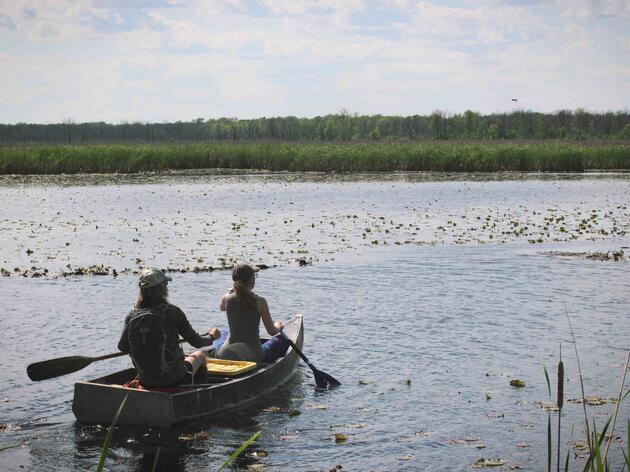Protecting Birds in the Saginaw Bay Region
The vast wetlands in the Saginaw Bay region provide critical habitat for a variety of waterbird species that use the area to rest and refuel during migration and for habitat and food during winter and breeding seasons.
Saginaw Bay’s coastal wetlands, including Wigwam Bay State Wildlife Area, Nayanquing Point State Wildlife Area, Quanicassee Wildlife Area, and Wild Fowl Bay State Park, make up the vast majority of the Bay’s 100-mile shoreline. These important wetlands face significant threats including invasive species and water-quality issues due to legacy contaminants and agricultural runoff.
Audubon Great Lakes is working with partners across the region to restore the region’s wetlands for the benefit of vulnerable marsh birds and local communities
Working in the Areas Where Birds Need Us Most
Explore Audubon’s Vision: Restoring the Great Lakes for Birds and People to see Audubon's plans to address the biggest threats facing birds and people.
Our Restoration Work
Since 2018, Audubon Great Lakes, in partnership with Michigan Department of Natural Resources (DNR) and the U.S. Fish and Wildlife Service Coastal Program, has been working to conserve wetlands at Wigwam Bay State Wildlife Area, a major breeding area for the Black Tern, a Michigan Species of Special Concern and State Wildlife Action Plan focal species. The colony at Wigwam Bay is suffering from habitat degradation due to invasive plants, loss of floating nest mats, severe weather events, and mammalian predators. The habitat work led by Audubon Great Lakes aims to improve hemi-marsh conditions and combat invasive species.
Audubon Great Lakes and Detroit Audubon staff and volunteers help lead marsh bird surveys and Black Tern surveys to measure the impact of restoration on breeding birds.
The region’s extensive state-owned land used for game and wildlife management provides many unique opportunities for restoration, enhancement and community engagement to support the support the region’s threatened marsh birds while improving foraging for gamebirds and waterbirds.
History of the Region
Historically, the Saginaw Bay region was once home to an abundance of swamps and other wetlands, which supported a variety of waterfowl and other wildlife. When Europeans settled in the region, they drained many of the swamps to make room for industry. Industrial wastewater, sewer overflows, contaminated sediments, urban and agricultural runoff, old waste disposal sites, and atmospheric deposition has led to the contamination of the region’s watershed.
The Saginaw River and Bay was designated as an EPA Area of Concern (AOC) due to contaminated sediments, fish consumption advisories, degraded fisheries and loss of significant recreational opportunities. Priorities in the AOC include pollution control, wetland and habitat restoration, and the removal of contaminated sediment.
Saginaw Bay is recognized as a globally significant Audubon Important Bird Area (IBA), for the habitat it provides to migratory waterbirds. Large congregations of waterfowl, including Tundra Swans, American Black Ducks, Mallards, Redheads, Common Goldeneyes, mergansers and scaup species flock to the marshes and open water of Saginaw Bay in spring and fall. Additionally, several important waterbird breeding colonies exist within the IBA, including Black Tern, Common Tern, Caspian Tern, Ring-billed Gull, Great Egret, and Black-crowned Night Heron.
The region’s wetlands are also important to the community. Wetlands serve as natural water purifiers that absorb pollutants to keep the water in inland lakes and streams clean. By storing water, wetlands also operate as natural flood control to protect local communities from flooding and drought and help buffer communities from a changing climate.
Project Partners & Supporters
Audubon Great Lakes is grateful to project partners and supporters who make our work possible.
Project Partners:
Supporters:
Audubon’s work in the Saginaw Bay region is supported by U.S. Fish and Wildlife Service’s Coastal Program, National Fish and Wildlife Foundation and the Great Lakes Restoration Initiative.










